Click on images to enlarge
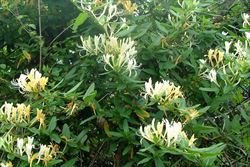
habit in flower (Photo: Sheldon Navie)

climbing habit (Photo: Sheldon Navie)
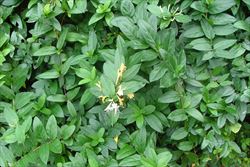
scrambling habit (Photo: Sheldon Navie)
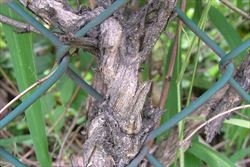
very old woody stem (Photo: Sheldon Navie)
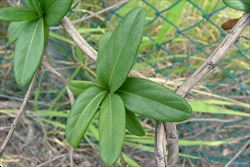
leaves borne on older stems (Photo: Sheldon Navie)

leaves boren on new growth (Photo: Sheldon Navie)
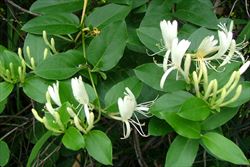
leaves and younger flowers (Photo: Sheldon Navie)

older yellowish-coloured flowers (Photo: Sheldon Navie)

paired leaves, reddish stems and pinkish-tinged flowers (Photo: Sheldon Navie)
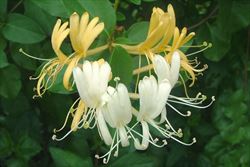
close-up of flowers, with wider four-lobed upper lips and narrow single-lobed lower lips (Photo: Sheldon Navie)
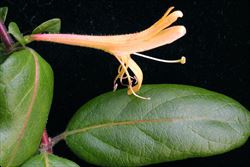
close-up of older flower from side-on, showing the long flower tube (Photo: Greg Jordan)
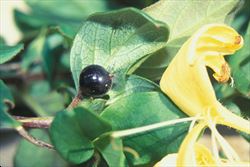
shiny black mature fruit (Photo: Forest and Kim Starr, USGS)
Scientific Name
Lonicera japonica Thunb.
Synonyms
Caprifolium japonicum (Thunb.) Dum. Cours.Nintooa japonica (Thunb.) Sweet
Family
Caprifoliaceae
Common Names
Chinese honeysuckle, gold and silver flower, Hall's honeysuckle, honeysuckle, Japanese honeysuckle, woodbine
Origin
Native to eastern Asia (i.e. eastern China, Korea and Japan).
Cultivation
Japanese honeysuckle (Lonicera japonica) is widely and commonly cultivated as a garden ornamental in Australia.
Naturalised Distribution
Widely naturalised in southern and eastern Australia. It is common in south-eastern Queensland, the coastal and sub-coastal districts of eastern New South Wales, the ACT, many parts of Victoria, Tasmania, south-eastern South Australia and south-western Western Australia. Also recorded from northern Queensland and naturalised on Norfolk Island.
Widely naturalised in other parts of the world including the UK, central Europe, sub-Saharan Africa, New Zealand, Hawaii, the USA and southern South America.
Habitat
This species has mainly become naturalised in or near rainforests and other closed forests, particularly those close to habitation. It also grows in riparian areas, distrubed sites and waste areas in wetter temperate, sub-tropical and tropical regions.
Habit
A woody climber or scrambler with stems growing up to 10 m long.
Distinguishing Features
- a climbing or scrambling plant with paired leaves along its stems.
- its distinctive flowers are two-lipped, the wider upper lip having four small lobes and the lower lip with a single lobe.
- these flowers are initially white or pinkish tinged, but turn cream or yellowish as they age.
- its fruit are shiny black berries (5-10 mm long).
Stems and Leaves
The younger stems are greenish or reddish in colour and usually have a dense covering of tiny hairs (i.e. they are finely pubescent). Older stems may become quite thick and woody, developing a greyish-coloured bark as they age.
The oppositely arranged leaves are generally hairless (i.e. glabrous) or sparsely hairy (i.e. puberulent) and are borne on short stalks (i.e. petioles) 3-10 mm long. These leaves (2.5-8 cm long and 1-4 cm wide) are usually oblong or egg-shaped in outline (i.e. ovate) with entire margins and pointed or rounded tips (i.e. acute or obtuse apices). However, leaves on seedlings and young plants may be somewhat lobed.
Flowers and Fruit
The fragrant flowers (4-5 cm long) are arranged in pairs in the forks (i.e. axils) of the upper leaves. They are surrounded by several pairs of green leafy bracts (5-20 mm long) and borne on stalks (i.e. peduncles) 5-50 mm long. Their petals are fused into a tube (i.e. corolla) for part of their length and then separate into two 'lips'. The upper lip is much wider and has four lobes at its tip, while the lower lip has a single lobe. These flowers are initially white in colour, though their outsides may be tinged with pink or purple, and they usually turn cream or yellowish with age. Flowering occurs mostly in autumn.
The egg-shaped (i.e. ovoid) fruit are shiny black berries (5-10 mm long), each containing a few seeds.
Reproduction and Dispersal
This species occasionally reproduces by seed, but more commonly it spreads vegetatively via its creeping stems which produce roots at their joints (i.e. via stolons).
Japanese honeysuckle (Lonicera japonica) seeds are dispersed by birds and other animals that eat the fruit, while the seeds and stem segments are also spread by water, in dumped garden waste, by slashers and in contaminated soil.
Environmental Impact
Japanese honeysuckle (Lonicera japonica) is regarded as an environmental weed in Queensland, New South Wales, the ACT, Victoria, Tasmania, South Australia and Western Australia. This species is actively managed by community groups in New South Wales and was recently listed as a priority environmental weed in six Natural Resource Management regions. It also appears in the Global Invasive Species Database (GISD).
Legislation
This species is declared under legislation in the following states and territories:
- ACT: C4 - prohibited - a pest plant whose supply is prohibited in the ACT.
- Western Australia: Unassessed - this species is declared in other states or territories and is prohibited until assessed via a weed risk assessment (throughout the entire state).
Management
For information on the management of this species see the following resources:
- the Biosecurity Queensland Fact Sheet on this species, which is available online at http://www.dpi.qld.gov.au.
- the Japanese honeysuckle page on the South Coast Weeds website at http://www.esc.nsw.gov.au/Weeds/index.asp.
- Muyt (2001), Bush Invaders of South-east Australia, pp. 197-198.
Similar Species
Japanese honeysuckle (Lonicera japonica) can be confused with winter honeysuckle (Lonicera fragrantissima) and European honeysuckle (Lonicera periclymenum). However, these species can be distinguished by the following differences:
- Japanese honeysuckle (Lonicera japonica) is a climber or scrambling shrubby plant with hairy (i.e. pubescent) younger stems. Its flowers are borne in pairs in the leaf forks and its mature fruit a black in colour.
- winter honeysuckle (Lonicera fragrantissima) is an upright shrubby plant with hairless (i.e. glabrous) younger stems. Its flowers are borne in pairs in the leaf forks and its mature fruit are red in colour.
- European honeysuckle (Lonicera periclymenum) is a climber or scrambling shrubby plant with hairy (i.e. pubescent) reddish-coloured younger stems. Its flowers are borne in dense clusters at the tips of the branches and its mature fruit are red in colour.

